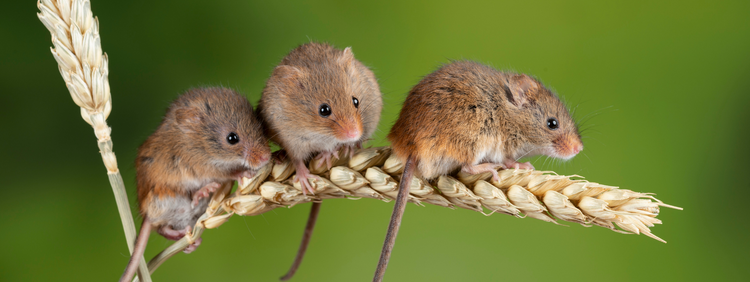3 Species of Mice Found in Markham

It can be difficult to tell different species of mice apart. The differences in their appearances can be subtle, and because mice are shy, skittish creatures, it can be difficult to get a good look at them before they seek cover. It isn’t strictly necessary for you to determine which species of mouse is infesting your house; when we perform mice control in Markham, identification is part of our process. However, you should be aware of the problems that different species of mice can cause in your home.
1. Deer Mouse
The deer mouse — specifically, the Eastern deer mouse — is one of Ontario’s most widespread mouse species. Deer mice’s odds of getting into your home are pretty good because of their sheer numbers.
The most noticeable feature of the deer mouse is its eyes, which are disproportionately large and protuberant. Deer mice also have large round ears. Their back is covered with brown or grey fur, and their feet and underbellies are white.
Deer mice are very adept at climbing with their sharp claws. In the wild, they prefer to nest up in trees, but in an urban environment, they may use their remarkable climbing abilities to scale the side of your house and nest in your cozy attic. Deer mice can reproduce throughout the year, especially when the weather is warm. Young deer mice are ready to reproduce at about six weeks old, so an infestation can grow quickly. Deer mice are among a handful of rodent species known to carry hantavirus and spread it to humans, so an infestation is a cause for concern and caution.
2. Field Mouse
As implied by the name, field mice prefer to live outside, where they forage for food. However, in the winter, when temperatures drop and food becomes more scarce, they may be lured inside by the warmth, especially if food is plentiful.
Field mice have relatively small eyes and ears compared to other mouse species. Their coat colour ranges from dark brown to red-brown. Their bellies are white, but their feet are the same colour as the rest of their coat. Their bodies are about 10.5 cm long, with a tail that’s slightly shorter, and they weigh up to 27 g. Their diet includes root vegetables, earthworms, mushrooms, berries, and young plants. It varies by season depending on what’s available. They’d generally prefer to forage in the garden than get inside your house, but a field mouse infestation of your home is not out of the question.
3. House Mouse
Most species of mice are opportunistic and will invade a home if it seems advantageous to them. The house mouse is so called because it, out of all the mouse species in Ontario, is specifically adapted to live alongside humans and actively seeks out human homes to make their nests. Therefore, many calls for residential pest control are about house mice.
The eyes and ears of a house mouse are larger than a field mouse’s but smaller than a deer mouse’s. Its coat is grey-brown in colour all over its body, including the feet and the underbelly.
House mice are not known to spread hantavirus to humans, but that’s about the only good news about them. Like all rodents, the house mouse’s front teeth never stop growing, and they can cause extensive property damage by gnawing to file them down. All mice are relatively intelligent, but because house mice have evolved to live alongside humans, they are even better at evading do-it-yourself pest control.
Call Truly Nolen for Mice Control in Markham
Our approach to home pest control involves an inspection to identify the mouse species infesting your home. Then we work with you to develop a customized plan, which usually involves trapping the mice, cleaning up after them, and rodent-proofing against future infestations. Learn more about the services we offer in your area.